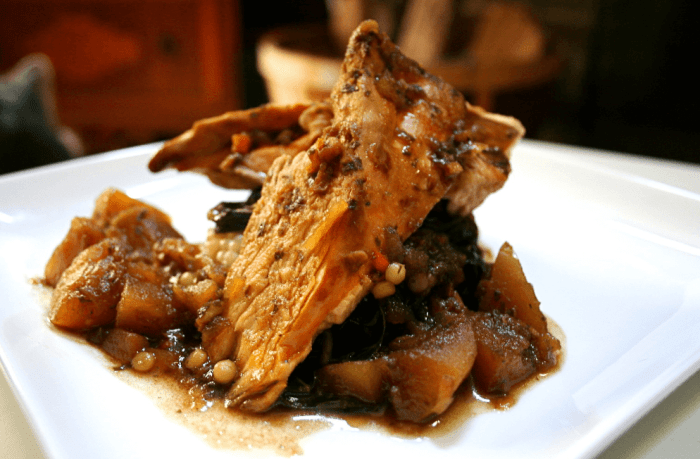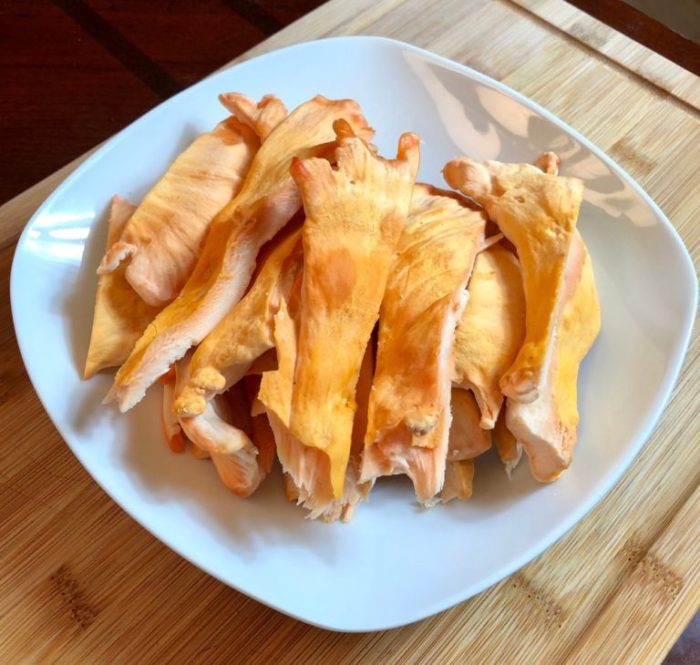
Prepare to embark on a culinary adventure with our comprehensive guide to chicken of the woods recipe. From identifying and harvesting these vibrant mushrooms to exploring their diverse culinary applications, we’ll guide you through every step of the way.
Chicken of the woods, known for its striking appearance and delectable flavor, offers a unique and sustainable source of nourishment. Its versatility in the kitchen makes it a favorite among mushroom enthusiasts and adventurous cooks alike.
Introduction to Chicken of the Woods
Chicken of the Woods (Laetiporus sulphureus) is a unique and delectable wild mushroom that has gained popularity among foragers and culinary enthusiasts alike. This mushroom stands out with its vibrant orange-yellow color, resembling the plumage of a chicken, hence its common name.
Chicken of the Woods is a versatile culinary ingredient, prized for its tender texture and savory flavor. Its meaty consistency and subtle, slightly sweet taste make it an excellent substitute for chicken in various dishes. Additionally, it is a rich source of dietary fiber, vitamins, and minerals, making it a nutritious addition to any meal.
Characteristics and Edibility
Chicken of the Woods is characterized by its large, shelf-like fruiting bodies that can grow up to several feet in width. These fruiting bodies are composed of overlapping layers of bright orange-yellow flesh, which can vary in thickness. The undersurface of the mushroom features tiny pores, distinguishing it from other similar-looking species.
Chicken of the Woods is considered edible and safe to consume when cooked thoroughly. However, it is crucial to note that there are look-alike species that can be poisonous. Therefore, it is highly recommended to only harvest and consume Chicken of the Woods if you are confident in its identification.
Culinary Value
Chicken of the Woods offers a wide range of culinary applications, making it a versatile ingredient for both savory and vegetarian dishes. Its tender texture and subtle flavor make it an excellent substitute for chicken in stir-fries, soups, stews, and pasta dishes.
Additionally, it can be grilled, roasted, or fried to create flavorful and satisfying vegan or vegetarian meals.
The versatility of Chicken of the Woods extends to its compatibility with various seasonings and spices. It readily absorbs flavors, allowing you to customize dishes to your taste preferences. Whether you prefer a simple salt and pepper seasoning or a more complex blend of herbs and spices, Chicken of the Woods will elevate the flavors of your culinary creations.
Recipe Variations

Chicken of the Woods is a versatile mushroom that can be used in a variety of dishes. Here are a few popular recipes that feature this delicious fungus:
Soups and Stews
- Chicken of the Woods Soup:This hearty soup is made with chicken of the woods, potatoes, carrots, celery, and onion. It’s a great way to warm up on a cold day.
- Chicken of the Woods Stew:This stew is similar to the soup, but it includes more vegetables, such as tomatoes, green beans, and corn. It’s a hearty and flavorful dish that’s perfect for a winter meal.
Stir-fries
- Chicken of the Woods Stir-fry:This stir-fry is a quick and easy way to cook chicken of the woods. It’s made with chicken of the woods, your favorite vegetables, and a stir-fry sauce.
- Chicken of the Woods with Garlic and Ginger:This stir-fry is a simple but flavorful dish that’s made with chicken of the woods, garlic, ginger, and soy sauce.
Other Dishes
- Chicken of the Woods Pizza:This pizza is made with chicken of the woods, mozzarella cheese, and your favorite toppings. It’s a delicious and unique way to enjoy this mushroom.
- Chicken of the Woods Tacos:These tacos are made with chicken of the woods, your favorite taco toppings, and a salsa of your choice. They’re a quick and easy way to enjoy this mushroom.
Nutritional Benefits: Chicken Of The Woods Recipe

Chicken of the Woods is not just delicious but also highly nutritious. It’s a good source of vitamins, minerals, and antioxidants.
Vitamins and Minerals
Chicken of the Woods is rich in vitamins B1, B2, B3, and D. It also contains potassium, phosphorus, magnesium, and iron.
Antioxidants
Chicken of the Woods contains several antioxidants, including ergothioneine, which is known for its anti-inflammatory and anti-cancer properties.
Potential Health Benefits
The nutritional value of Chicken of the Woods suggests it may have several potential health benefits, including:
- Boosted immune function
- Reduced inflammation
- Improved heart health
- Reduced risk of cancer
4. Identification and Harvesting
Foraging for Chicken of the Woods requires keen observation and responsible practices to ensure a sustainable harvest. Here’s a comprehensive guide to help you identify, locate, and harvest this delectable mushroom safely.
Identification
Chicken of the Woods, scientifically known as Laetiporus sulphureus, is characterized by its distinctive appearance and habitat. It typically grows in shelf-like clusters on the trunks of deciduous trees, particularly oaks and maples. The mushroom features vibrant orange to yellow hues, with a velvety texture and a fleshy, chicken-like consistency.
Look-alikes, Chicken of the woods recipe
While Chicken of the Woods is relatively easy to identify, there are a few look-alikes to be aware of. These include the False Chicken of the Woods ( Hypholoma fasciculare) and the Sulfur Shelf ( Laetiporus gilbertsonii). The False Chicken of the Woods has a more slender and fibrous texture, while the Sulfur Shelf is generally larger and has a more yellow coloration.
It’s crucial to consult field guides or consult with experienced foragers to confirm your identification before consuming any wild mushrooms.
Harvesting
When harvesting Chicken of the Woods, it’s essential to follow responsible practices to ensure its sustainability. Choose young, firm specimens with minimal bruising or damage. Use a sharp knife to cut the mushroom cleanly from the tree, leaving the base intact.
Avoid over-harvesting and always leave some mushrooms behind for future growth and spore dispersal. Remember, foraging for wild mushrooms should be done in moderation and with respect for the environment.
5. Culinary Applications
Chicken of the Woods is a versatile culinary delight, offering a wide range of applications. Its meaty texture and savory flavor make it an excellent substitute for chicken in many dishes.
Before preparing, clean the mushroom thoroughly by brushing off any debris and slicing it into bite-sized pieces. To enhance its flavor, marinate it in a mixture of olive oil, herbs, and spices for at least 30 minutes.
Cooking Methods
- Sautéing:Heat a pan with some oil and sauté the mushroom slices until golden brown and tender.
- Grilling:Grill the mushroom slices over medium heat until they develop grill marks and become slightly charred.
- Roasting:Toss the mushroom slices with olive oil and roast them in a preheated oven at 400°F (200°C) for 15-20 minutes, or until they are tender and slightly browned.
- Frying:Dip the mushroom slices in a batter or breading mixture and fry them in hot oil until crispy and golden brown.
Pairing Suggestions
Chicken of the Woods pairs well with various ingredients and flavors, such as:
- Vegetables:Asparagus, broccoli, carrots, onions, and bell peppers.
- Herbs:Thyme, rosemary, oregano, and basil.
- Spices:Garlic, paprika, cumin, and cayenne pepper.
- Sauces:Creamy sauces, tomato sauces, and vinaigrettes.
Closing Notes

Whether you’re a seasoned chef or a curious home cook, our chicken of the woods recipe will inspire you to create mouthwatering dishes that showcase the earthy flavors of the forest. So, let’s dive into the world of chicken of the woods and unlock its culinary potential!
FAQ Resource
What is the best way to identify chicken of the woods?
Look for large, shelf-like clusters with bright orange or yellow coloration and a velvety texture.
How do you prepare chicken of the woods for cooking?
Clean the mushrooms thoroughly and remove any tough or woody parts. Cut into bite-sized pieces.
What are some popular ways to cook chicken of the woods?
Sauté, roast, grill, or add to soups, stews, and stir-fries.





